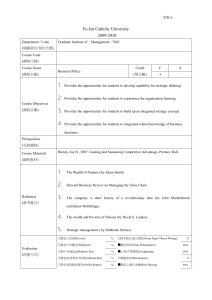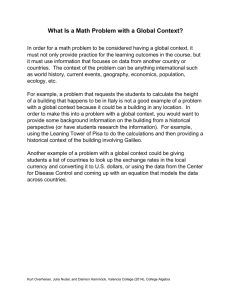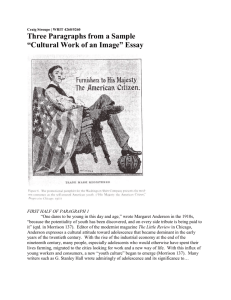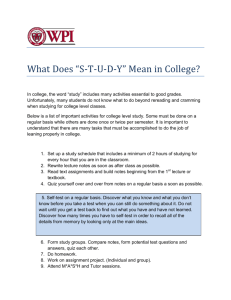Lecture 1: Basic Concepts of Machine Leaning
advertisement
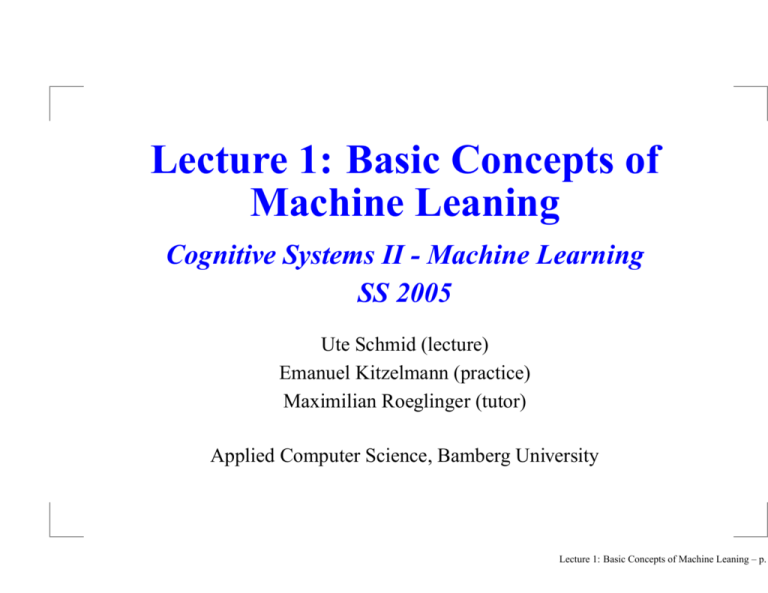
Lecture 1: Basic Concepts of
Machine Leaning
Cognitive Systems II - Machine Learning
SS 2005
Ute Schmid (lecture)
Emanuel Kitzelmann (practice)
Maximilian Roeglinger (tutor)
Applied Computer Science, Bamberg University
Lecture 1: Basic Concepts of Machine Leaning – p.
Organization of the Course
Homepage:
http://www.cogsys.wiai.uni-bamberg.de/teaching/
Prerequesites: CogSys I
Textbook: Tom Mitchell (1997). Machine Learning.
McGraw Hill.
Practice
Programming Assignments in Java
Marked exercise sheets and extra points for the exam
Lecture 1: Basic Concepts of Machine Leaning – p.
Outline of the Course
Basic Concepts of Machine Learning
Basic Approaches to Concept Learning
Foundations of Concept Learning
Decision Trees
Perceptrons and Multilayer-Perceptrons
Human Concept Learning
Special Aspects of Concept Learning
Inductive Logic Programming
Genetic Algorithms
Instance-based Learning
Bayesian Learning
Lecture 1: Basic Concepts of Machine Leaning – p.
Outline of the Course
Learning Programs and Strategies
Reinforcement Learning
Inductive Function Synthesis
Further Topics and Applications in Machine Learning
Lecture 1: Basic Concepts of Machine Leaning – p.
Course Objectives
introduce to the central approaches of machine
learning
point out relations to human learning
define a class of problems that encompasses
interesting forms of learning
explore algorithms that solve such problems
provide understanding of the fundamental structure of
learning problems and processes
Lecture 1: Basic Concepts of Machine Leaning – p.
Some Quotes as Motivation
If an expert system–brilliantly designed, engineered and
implemented–cannot learn not to repeat its mistakes, it is
not as intelligent as a worm or a sea anemone or a kitten.
Oliver G. Selfridge, from The Gardens of Learning
Find a bug in a program, and fix it, and the program will
work today. Show the program how to find and fix a bug,
and the program will work forever.
Oliver G. Selfridge, in AI’s Greatest Trends and Controversies
If we are ever to make claims of creating an artificial
intelligence, we must address issues in natural language,
automated reasoning, and machine learning.
George F. Luger
Lecture 1: Basic Concepts of Machine Leaning – p.
What is Machine Learning?
Some definitions
Machine learning refers to a system capable of the
autonomous acquisition and integration of knowledge. This
capacity to learn from experience, analytical observation,
and other means, results in a system that can
continuously self-improve and thereby offer increased
efficiency and effectiveness.
http://www.aaai.org/AITopics/html/machine.html
The field of machine learning in concerned with the
question of how to construct computer programms that
automatically improve with experience.
Tom M. Mitchell, Machine Learning (1997)
Lecture 1: Basic Concepts of Machine Leaning – p.
What is Machine Learning?
machine learning is inherently a multidisciplinary field
i.e. artificial intelligence, probability, statistics,
computational complexity theory, information
theory, philosophy, psychology, neurobiology, ...
Knowledge-based vs. Learning Systems
Different approaches
Concept vs. Classification Learning
Symbolic vs. Statistical Learning
Inductive vs. Analytical Learning
Lecture 1: Basic Concepts of Machine Leaning – p.
Knowledge-based vs. Learning Systems
Knowledge-based Systems: Acquisition and modeling of
common-sense knowledge and expert knowledge
⇒ limited to given knowledge base and rule set
⇒ Inference: Deduction generates no new knowledge
but makes implicitly given knowledge explicit
⇒ Top-Down: from rules to facts
Learning Systems: Extraction of knowledge and rules from
examples/experience
Teach the system vs. program the system
Learning as inductive process
⇒ Bottom-Up: from facts to rules
Lecture 1: Basic Concepts of Machine Leaning – p.
Knowledge-based vs. Learning Systems
⇒ A flexible and adaptive organism cannot rely on a fixed
set of behavior rules but must learn (over its complete
life-span)!
⇒ Motivation for Learning Systems
Lecture 1: Basic Concepts of Machine Leaning – p. 1
Knowledge
Engineering
Acquisition
Knowledge Acquisition Bottleneck
EXPERT
SYSTEM
(Feigenbaum, 1983)
Break-through in computer
chess with Deep Blue:
Evaluation function of chess
grandmaster Joel Benjamin.
Deep Blue cannot change the
evaluation function by itself!
Experts are often not able to
verbalize their special
knowledge.
⇒ Indirect methods: Extraction
of knowledge from expert
behavior in example situations
(diagnosis of X-rays, controlling
a chemical plant, ...)
Lecture 1: Basic Concepts of Machine Leaning – p. 1
Learning as Induction
Deduction
Induction
All humans are mortal.
(Axiom)
Socrates is human.
(Background K.)
Socrates is human.
(Fact)
Socrates is mortal.
(Observation(s))
Conclusion:
Generalization:
Socrates is mortal.
All humans are mortal.
Deduction: from general to specific ⇒ proven correctness
Induction: from specific to general ⇒ (unproven)
knowledge gain
Induction generates hypotheses not
knowledge!
Lecture 1: Basic Concepts of Machine Leaning – p. 1
Epistemological problems
⇒ pragmatic solutions
Confirmation Theory: A hypothesis obtained by
generalization gets supported by new observations
(not proven!).
grue Paradox:
All emeralds are grue.
Something is grue, if it is green before a future time t
and blue thereafter.
⇒ Not learnable from examples!
Lecture 1: Basic Concepts of Machine Leaning – p. 1
Inductive Learning Hypothesis
as shown above inductive learning is not proven
correct
nevertheless the learning task is determine a
hypothesis h ∈ H identical to the target concept c
(∀x ∈ X)[h(x) = c(x)]
only training examples D are available
inductive algorithms can at best guarantee that the
output hypothesis D fits the target concept over D
(∀x ∈ D)[h(x) = c(x)]
⇒ Inductive Learning Hypothesis: Any hypothesis found to
approximate the target concept well over a sufficiently
large set of training examples will also approximate the
target function well over other unobserved examples
Lecture 1: Basic Concepts of Machine Leaning – p. 1
Concept vs. Classification Learning
Concept learning:
Objects are clustered in concepts.
Extensional: (infinite) set of all exemplars
Intensional: finite characterization
T = {x| has-3/4-legs(x), has-top(x)}
11111
00000
00000
11111
0
1
0
1
0
1
0
1
0
1
0
1
0
1
0
1
Construction of a finite characterization from a subset
of examples (“training set”).
Classification learning:
Identification of relevant attributes and their
interrelation, which characterize an object as member
of a class.
f : Xn → K
Lecture 1: Basic Concepts of Machine Leaning – p. 1
Concept Learning / Examples
+ Occurence of Tse-Tse fly yes/no, given geographic
and climatic attributes
+ risk of cardiac arrest yes/no, given medical data
+ credit-worthinessof customer yes/no, given personal
and customer data
+ safe chemical process yes/no, given physical and
chemical measurements
Generalization of pre-classified example data,
application for prognosis
Lecture 1: Basic Concepts of Machine Leaning – p. 1
Symbolic vs. Statistical Learning
Symbolic Learning: underlying learning strategies such as
rote learning, learning by being told, learning by
analogy, learning from examples and learning from
discovery
knowledge is represented in the form of symbolic
descriptions of the learned concepts, i.e.
production rules or concept hierarchies
i.e. decision trees, inductive logic programming
Statistical Learning: modeling of the behaviour
sometimes called statistical inference,
connectionstic learning
i.e. Artificial Neuronal Networks, Bayesian
Learning
Lecture 1: Basic Concepts of Machine Leaning – p. 1
Designing a Learning System
learning system: A computer program is said to learn
from experience E with respect to some class of tasks
T and performance measure P , if its performance at
tasks in T , as measured by P , improves with
experience E .
i.e. a checkers learning problem
T : playing checkers
P : percent of games won against opponents
E : playing practice games against itself
Lecture 1: Basic Concepts of Machine Leaning – p. 1
Designing a Learning System
consider designing a program to learn to play checkers
in order to illustrate some of the basic design issues
and approaches to machine learning
1. Choosing the Training Experience
direct or indirect feedback
degree to which the learner controls the sequence
of training examples
representativity of the distribution of the training
examples
⇒ significant impact on success or failure
Lecture 1: Basic Concepts of Machine Leaning – p. 1
Designing a Learning System
2. Choosing the Target Function
determine what type of knowledge will be learned
most obvious form is a function, that chooses the best move for
any given board state
i.e., ChooseM ove : B → M
sometimes evaluation functions are easier to learn
i.e., V : B → <
assigns higher values to better boards states by recursively
generating the successor states and evaluating them until the
game is over
no efficient solution (nonoperational definition)
⇒ function approximation is sufficient (operational definition)
Lecture 1: Basic Concepts of Machine Leaning – p. 2
Designing a Learning System
3. Choosing a Representation for the Target Function
e.g. a large table, a set of rules or a linear function
e.g. V (b) = w0 + w1 x1 + w2 x2 + ... + wi xi
4. Choosing a Function Approximation Algorithm
5. Estimating Training Values
it is easy to assign a value to a final state
the evaluation of intermediate states is more difficzult
Lecture 1: Basic Concepts of Machine Leaning – p. 2
Designing a Learning System
Determine Type
of Training Experience
Games against
experts
Games against
self
...
Table of correct
moves
Determine
Target Function
Board
➝ move
...
Board
➝ value
Determine Representation
of Learned Function
Polynomial
...
Linear function
of six features
Artificial neural
network
Determine
Learning Algorithm
Gradient
descent
Linear
programming
...
Completed Design
Lecture 1: Basic Concepts of Machine Leaning – p. 2
Notation
Instance Space X: set of all possible examples over which the
concept is defined (possibly attribute vectors)
Target Concept c : x → {0, 1}: concept or function to be learned
Training example x ∈ X of the form < x, c(x) >
Training Set D: set of all available training examples
Hypothesis Space H: set of all possible hypotheses according to the
hypothesis language
Hypothesis h ∈ H: boolean valued function of the form X → {0, 1}
⇒ the goal is to find a h ∈ H, such that (∀x ∈ X)[h(x) = c(x)]
Lecture 1: Basic Concepts of Machine Leaning – p. 2
Properties of Hypotheses
general-to-specific ordering
naturally occuring order over H
learning algorithms can be designed to search H exhaustively
without explicitly enumerating each hypothesis h
hi is more general or equal to hk (written hi ≥g hk )
⇔ (∀x ∈ X)[(hk (x) = 1) → (hj (x) = 1)]
hi is (stricly) more general to hk (written hi >G hk )
⇔ (hj ≥g hk ) ∧ (hk g hi )
≥g defines a partial ordering over the Hypothesis Space H
Lecture 1: Basic Concepts of Machine Leaning – p. 2
Properties of Hypotheses - Example
h1 = Aldo loves playing Tennis if the sky is sunny
h2 = Aldo loves playing Tennis if the water is warm
h3 = Aldo loves playing Tennis if the sky is sunny and the water is warm
⇒ h1 >g h3 , h2 >g h3 , h2 6> h1
Lecture 1: Basic Concepts of Machine Leaning – p. 2
Properties of Hypotheses
consistency
a hypothesis h is consistent with a set of training examples D iff
h(x) = c(x) for each example < x, c(x) > in D
Consistent(h, D) ≡ (∀ < x, c(x) >∈ D)[h(x) = c(x)]
that is, every example in D is classified correctly by the
hypothesis
Lecture 1: Basic Concepts of Machine Leaning – p. 2
Properties of Hypotheses - Example
h1 is consistent with D
Lecture 1: Basic Concepts of Machine Leaning – p. 2
